HOME|Ideas and resoueces for planetary science experiments|Determining Lunar Surface Properties from Craters
宇宙の実験教室
Ideas and resoueces for planetary science experiments
カテゴリ
Category
- 実験教室Idea and Resources for Space science experiments
- 対象項目別Category: Contents
- 学年単元別Category: Study Age
-
- 実践授業Activity Reports
タグ
Tag
 月の表面のようす
月の表面のようす
ねらい
クレーター地形を観察し、地形のでき方を考えてみよう。
月や惑星・衛星の表層には,衝突クレーターが多数あります。これは、隕石などの小天体が表層に衝突して形成した穴です。
この実験では、これらのクレーター地形をアポロの月面探査機が撮影した写真を使って判読することを紹介し、写真の電子データを提供しています。
写真の判読によって、望遠鏡による観察では気づきにくい細かい地形を観察することができます。地形の新旧についても考察することができ、地球上の地形のでき方に応 用することもできるでしょう。
実験方法
用意するもの
筆記用具、トレーシングペーパー、下にあるアポロの月面写真を印刷したもの↓クリックすると大きな写真が見られます
| 上3つは、危難の海の盆地です。 |  |
 |
 |
| Apollo17-M0286 | Apollp17-M0289 | Apollo16-M0293 | |
| 下二つは嵐の大洋の溶岩地形、右は月の裏側にあるエイトケンクレーターです。 |  |
 |
 |
| Apollo17-M0293 | Apollo16-M2837 | Apollo17-M0286 |
Apollo16&17 Metric Photography
写真の電子データ化は宮城県立角田高校 野町聡志先生による
地形を写してみよう
どんな地形がみられるか、写真から特徴的な地形をトレースしてみましょう。
また、どのようにしてその地形ができたかを考えましょう。
実験結果
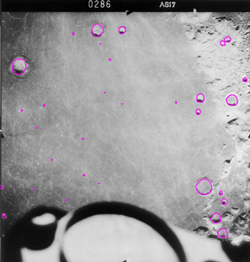
NASA National Space Science Data Centre Apollo17-M0286 Metric Photography 写真の電子データ化は宮城県立角田高校 野町聡志先生による
トレーシングペーパーの上から、見つけたクレーターをピンク色の線でなぞりました。
考えよう
どっちが新しい!?
クレーターの地形をよく観察して、どちらのクレーターがより昔にできたのかを考えてみましょう。
このようにクレーターが重なった地形はありませんでしたか?
ピンク色と水色のクレーターではどちらが昔にできたでしょう?

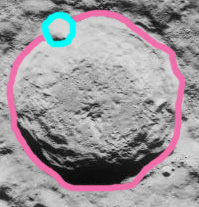
NASA National Space Science Data Centre Apollo17-M0293 Metric Photography
写真の電子データ化は宮城県立角田高校 野町聡志先生による
水色のクレーターの方が新しい
ピンク色のペンと水色のペンを使って自分で絵を描いてみるとわかりやすいです。
| ピンク色のクレーターの方が昔に出来たとしたら... | 水色のクレーターの方が昔に出来たとしたら... | ||
| 1.最初にピンク色のクレーターができる | 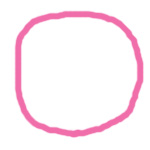 |
1.最初に水色のクレーターができる |  |
| 2.その上に水色のクレーターができる | 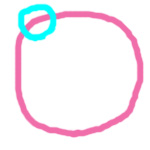 |
2.その上にピンク色のクレーターができる | 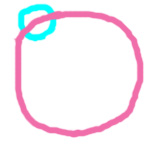 |
| 3.水色のクレーターがピンク色のクレーターの縁を消してしまう | 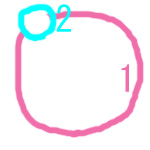 |
3.ピンク色のクレーターが水色のクレーターの縁を消してしまう | 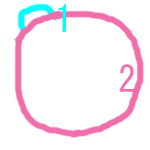 |
このように、クレーターの地形の重なり方から、クレーターの新旧を読みとることができます。
他にもこのような重なり合ったクレーター地形を探してどちらが古いか、新しいか、考えてみましょう。
 Determining Lunar Surface Properties from Craters
Determining Lunar Surface Properties from Craters
Introduction
By studying the topography of craters, try to determine how they were formed
The surface of the Moon and many planetary satellites are covered with a large number of impact craters. These features were produced the impact of small celestial bodies such as meteorites.
In this experiment, images of craters on the lunar surface acquired from Apollo missions are analyzed to determine crater topography.
Analysis of photographs allows a more detailed determination of crater topography to be made than by simply observing the Moon's surface through a telescope. By studying these images it is possible to determine the relative ages of different surface features.
Experimental Method
Things to Prepare
Writing materials; tracing paper; printouts of the Apollo images of the lunar surface below (click on an image to view a full-size version)
Apollo16&17 Metric Photography
Image processing by Satoshi Nomati, teacher at Kakuda High School, Miyagi Prefecture
Tracing Surface Features
Copy some of the surface features from the photographs using tracing paper.
Determining how these features were formed will require a lot of thought.
Experimental Results

NASA National Space Science Data Centre
Apollo17-M0286 Metric Photography
Image processing by Satoshi Nomati, teacher at Kakuda High School, Miyagi Prefecture
Craters identified in the image were outlined in pink on the tracing paper.
Discussion
Which Crater is Older?
By examining the topography of the two craters shown on the right, determine which was formed first.
Where the craters overlap, can you see which one was formed on top of the other?
Trace their outlines with pink and blue to determine which is the older crater.


NASA National Space Science Data Centre Apollo17-M0293 Metric Photography
Image processing by Satoshi Nomati, teacher at Kakuda High School, Miyagi Prefecture
The Blue Crater is Younger
It is easy to show this if you try drawing the pink and blue craters yourself.
| If we assume that the pink crater is older... | If we assume that the blue crater is older... | ||
| 1.The pink crater forms first |  |
1.The pink crater forms first |  |
| 2.Then the blue crater forms on top |  |
2.Then the pink crater forms on top |  |
| 3.The blue crater obliterates part of the rim of the pink crater |  |
3.The pink crater obliterates part of the rim of the blue crater |  |
The way in which craters are formed on top of each other helps us learn about the cratering process.
Studies of overlapping craters allow us to determine their relative ages.











